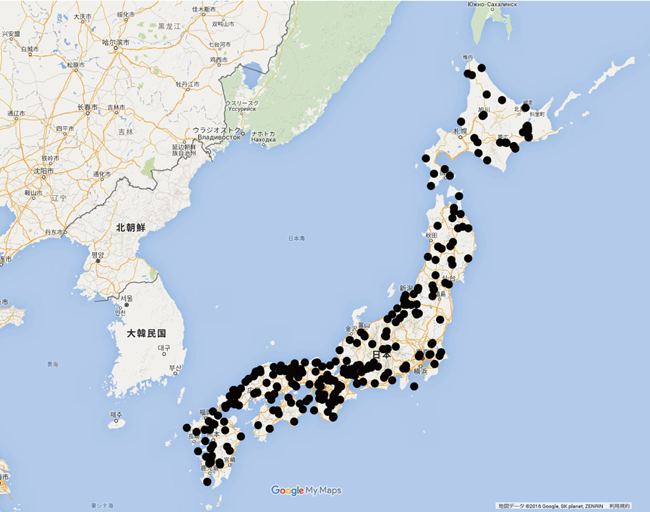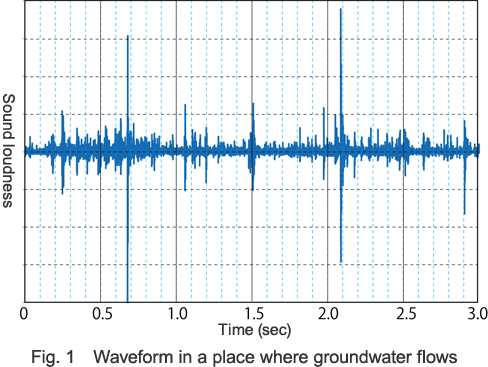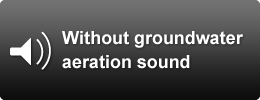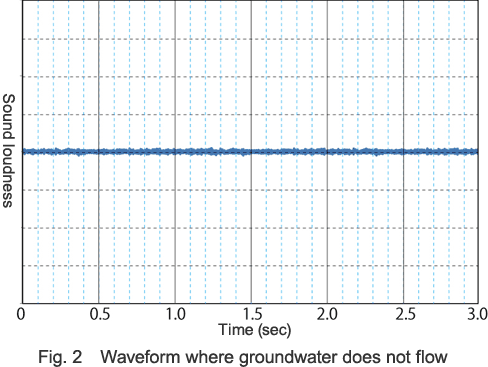Let's listen to groundwater aeration sound.
The figures show the sounds and their waveforms in a place where groundwater flows and in a place where it does not flow.
Click on the links to listen to the sounds in a place where groundwater flows and in a place where it does not flow, and compare them.
Have you heard the burbling and trickling sounds?
This is the groundwater aeration sound.
Explanations are given below about why such sounds are heard.

Mechanism of generation of groundwater aeration sound
Groundwater aeration sound denotes the burbling and trickling sounds given off when groundwater flows. The original sound of groundwater aeration sound cannot be distinguished with the sound of wind, the friction sounds of soil and gravel, etc. being mixed, but it becomes possible to hear the sound by reducing unnecessary sounds such as the sound of wind, the friction sounds, etc. through a filter.
The sound given off when groundwater flows is given off with the following mechanism.
In general, in soil layers on a slope in the state of no groundwater being generated, there exist air and water in gaps among the soil particles as shown in Fig. 3(a).
This is called an unsaturated state.
In an unsaturated state, water is adsorbed in small gaps (capillaries) among the soil particles.
Meanwhile, there exists air in large gaps. If water enters here from (1) as shown in Fig. 3(a), the air among the soil particles is pushed out to (2).
However, since the air-escape passage is plugged with (capillary) water adsorbed among the soil particles, the air must push through it.
At this time, in a way similar to make bigger soap bubbles, the (capillary) water that has been adsorbed in the gaps among the soil particles is pushed out by air, and a water film is formed in the traveling direction as shown in Fig. 3(b).
And at the same time that water fills the gaps among the soil particles, the water film is broken.
At this instant where the water film breaks, the burbling sound of a bursting bubble is given off.
This sound is called "aeration sound."
With regard to the waveforms in the place where groundwater flows as shown in Figs. 1 and 2, one waveform corresponds to one aeration sound which is the burbling sound.
The tone colors of this bubble include the trickling, burbling, and bubbling sounds having different pitches.
This is because the bubble size changes according to the size of the gap among the soil particles.
Large bubbles give off low pitch sounds, and small bubbles give off high pitch sounds.
When many bubbles such as these having various sizes, large and small, burst in the soil, groundwater aeration sound is given off.
In the meantime, in a place where plenty of groundwater flows, the air and water in the soil are exchanged with each other actively.
Namely, in a place where plenty of groundwater flows, a lot of bubbles burst, and the sound of the flowing groundwater intensifies.
The groundwater aeration sound measuring device identifies the place where groundwater flows (groundwater path) by looking for this place having intensified sound.

Results of measurement of groundwater aeration sound
Results of detection of groundwater aeration sound until the present are shown below.
In Japan, groundwater aeration sound was detected all over the country (Fig. 4).
Also, around the world, groundwater aeration sound was detected in the USA, Taiwan, Thailand, Indonesia, Mongolia, Myanmar, etc. (Fig. 5).
By overlapping the Köppen climate classification chart with the regions where groundwater aeration sound was detected, it can be seen that groundwater aeration sound was detected in the tropical zone, subtropical zone, temperate zone, subarctic zone, arctic zone, and desert climate, and the groundwater aeration sound measuring device can be used under various climatic conditions in the world.


| Tropical zone (A) | Tropical rainforest climate (Af) / Tropical monsoon climate (Am) / Savanna climate(Aw) / Tropical climate with dry summers (As) |
|---|---|
| Dry zone (B) | Desert climate: BWh, BWk / Steppe climate: BSh, BSk |
| Temperate zone (C) | Temperate humid climate (Cfa) / Marine west coast climate (Cfb, Cfc) / Temperate climate with dry winters (Cwa, Cwb, Cwc) / Mediterranean climate (Csa, Csb, Csc) / Subarctic humid climate (Dfa, Dfb. Dfc, Dfd) / Subarctic climate with dry winters (Dwa, Dwb, Dwc, Dwd) / Highland Mediterranean climate (Dsa, Dsb, Dsc, Dsd) |
| Cool temperate zone (D) | Humid continental climate | Continental mixed forests climate (Dfa, Dfb, Dwa, Dwb, Dsa, Dsb) / Subarctic climate | Coniferous forest climate (Dfc, Dfd, Dwc, Dwd, Dsc, Dsd) |
| Arctic zone (E) | ET(Tundra climate)(T: Tundre (tundra)) / EF (Nival climate)(F: Froste (below zero)) |





